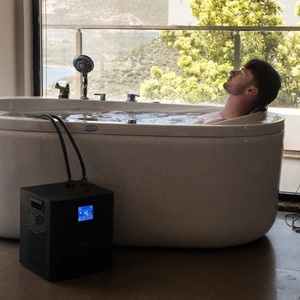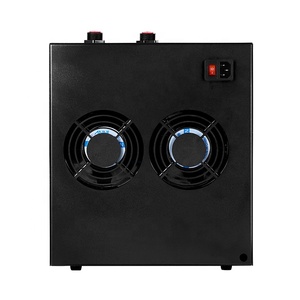
All categories
Featured selections
Trade Assurance
Buyer Central
Help Center
Get the app
Become a supplier

(1119 products available)

















































Direct connect water coolers remain popular among businesses looking for constant, high-volume water supplies. Below are some typical varieties:
Plumbed-in Water Cooler
This direct connect water cooler links to a constant water supply through plumbing. It offers unlimited water without the need for bottle replacement. It is ideal for high-demand environments like large offices, schools, etc. Its consistent water availability reduces maintenance and lowers running expenses compared to bottled water coolers.
Inline Filtration Water Cooler
This cooler includes an inline filter for enhanced water quality. The filter connects directly to the water source. It purges impurities, chlorine, etc., producing filtered water with fresher flavor. The filtration eliminates the need for bottled water delivery and cooler cleaning, making it a cleaner and healthier option for businesses.
Push-button Water Cooler
This water cooler features a push-button dispensing mechanism instead of a traditional tap. The design encourages users to use only the required amount of water, reducing waste. It also provides a hygienic, touchless dispensing option that minimizes contact with frequently used surfaces, which is essential for preventing the spread of germs in public and shared spaces.
Hot and Cold Plumbed Water Cooler
This water cooler provides both hot and cold water. It has separate compartments that are plumbed for heated and chilled water. Users can access cold water for refreshment and hot water for beverages and food preparation. The versatility of having two temperature options makes it suitable for diverse applications and eliminates the need for multiple dispensers in one location.
Office Break Room
An office environment is a great place for a direct water cooler dispenser. Employees need to stay hydrated throughout the day, and having a convenient water source helps with that. Cool water is always welcomed, especially when the weather is hot.
Factories
Both open and closed water coolers are great for use in factories. Workers are usually engaged in physically demanding tasks that make hydration very important. A factory setting may be dusty and fluorescent lighting and high-temperature environments can make working conditions unbearable.
Having a water cooler dispenser provides easy access to cool, refreshing water throughout the day. Workers can help themselves to water whenever they need to stay hydrated and maintain their energy levels.
Hospitals
Direct water coolers are useful in hospitals and other healthcare facilities. Visitors, patients, and hospital staff can easily get cold or room-temperature water from the water dispenser. Patients undergoing treatment tend to need constant hydration.
Instead of hospital staff fetching water for patients every time, a water cooler can make things a lot easier. Visitors to the Hospital can also use it when waiting to see their loved ones. It’ll minimize the consumption of hospital resources.
Schools
The direct water cooler dispenser is a common sight in schools. Children and teenagers need to stay hydrated as they go about their daily activities, especially during physical education and sports.
Besides that, it is easier and cheaper for the staff to set up a water cooler and allow students to serve themselves rather than fetching water for them all the time. The dispenser helps promote independence and self-service among students.
Gyms and Fitness Centers
A direct water cooler dispenser is a common sight in gyms and fitness centers. People work up a sweat and lose a lot of water when exercising. Staying hydrated is important when working out to prevent dehydration and maintain energy levels.
Having a direct water dispenser provides convenient access to water. Members can easily serve themselves whenever they feel thirsty.
When choosing a direct connect water cooler for home or office purposes, there are some critical factors to consider. Firstly, decide the preferred type of a direct connect water cooler. Both bottom and top servers can dispense hot, cold, and ambient water. However, the placement and technological features of both coolers are different. Secondly, consider the vital dimension and capacity of the cooler. Small-sized coolers are preferable for smaller spaces, while larger coolers with dispenser designs are better for big gatherings. A 3-liter to 5-liter tank is suitable for individual usage, while a 15-liter to 20-liter tank is more appropriate for commercial purposes.
Another feature to consider is how quickly and easily the cooler can refill water. Some coolers have a self-refilling feature as long as the tap water is available, eliminating the need for manual water refills. Water filtration is another important factor to consider. Some direct connect water coolers have advanced filtration systems that ensure pure, contaminant-free water. More filtration features lead to more filtration methods, so consider the preferred filtration system and choose a cooler that offers it.
Since most direct connect water coolers are used daily in homes and offices, ergonomic design and ease of functionality are vital. Choose a cooler whose controls are simple and easy to use. Finally, consider the power ratings of the cooler. Higher power ratings mean quicker water cooling abilities, but they will consume more electricity.
Q1: Can users install a direct water cooler themselves?
A1: Generally, water coolers are simple enough for users to install themselves. They just need to connect the water supply line and make sure there are no leaks. However, users may want a professional installation if there are complex plumbing requirements.
Q2: How often does the water in a direct dispenser need to be changed?
A2: The water can stay fresh for up to six months. However, it is best to use water that has been sitting in the cooler for three months or less. Any water that has been sitting for more than three months should be discarded. That said, people who work in facilities with high water demand should consult an expert to see how often the water needs to be changed.
Q3: Can other types of water besides purified water be used in a direct water cooler?
A3: Only purified water should be used. Other types of water, such as well water, stored water, or untreated municipal water, may contain contaminants that could pose health risks or damage the cooler.
Q4: How much energy does a direct water cooler consume?
A4: The energy usage varies by model. However, on average, a direct cooler uses about 30-40 watts of electricity when heating water and 15-20 watts when cooling it. Some models may use solar energy.
Q5: How long do direct water coolers last?
A5: The lifespan depends on the usage and maintenance. However, with proper maintenance, a direct water cooler can last for about 5-10 years or even longer.